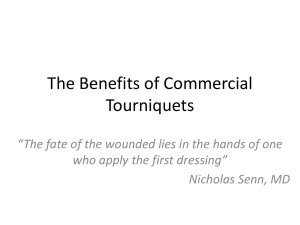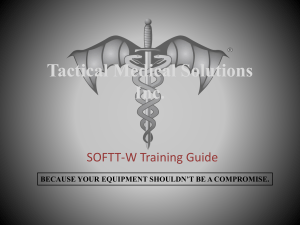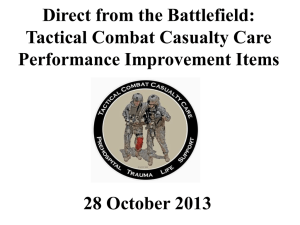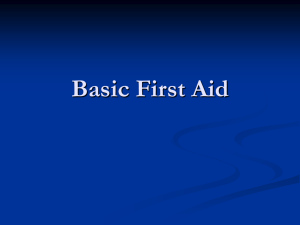Training Slides - Vighter Medical Group
advertisement
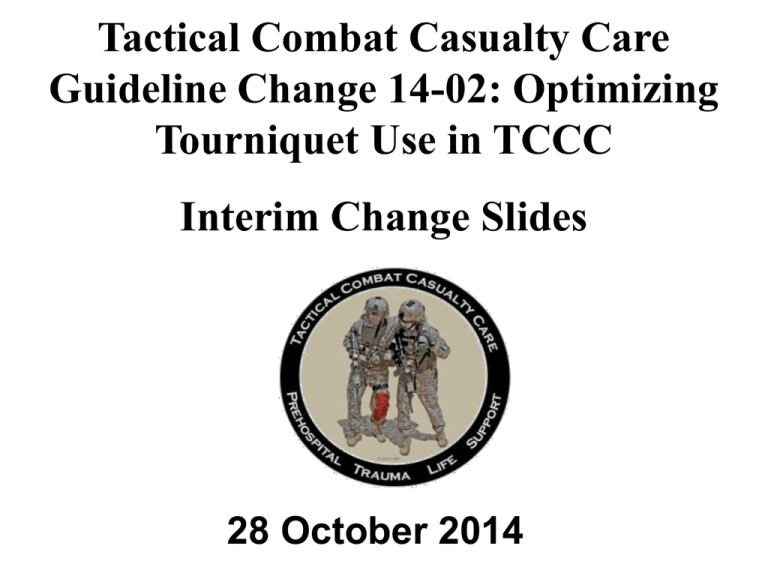
Tactical Combat Casualty Care Guideline Change 14-02: Optimizing Tourniquet Use in TCCC Interim Change Slides 28 October 2014 Care Under Fire Care Under Fire Guidelines 7. Stop life-threatening external hemorrhage if tactically feasible: • Direct casualty to control hemorrhage by self-aid if able. • Use a CoTCCC-recommended limb tourniquet for hemorrhage that is anatomically amenable to tourniquet use. • Apply the limb tourniquet over the uniform clearly proximal to the bleeding site(s). If the site of the life-threatening bleeding is not readily apparent, place the tourniquet “high and tight” (as proximal as possible) on the injured limb and move the casualty to cover. The Number One Medical Priority in CUF Early control of severe hemorrhage is critical. – Extremity hemorrhage in the past was the most frequent cause of preventable battlefield deaths. – Over 2500 deaths occurred in Vietnam secondary to hemorrhage from extremity wounds. – Injury to a major vessel can quickly lead to shock and death. – Only life-threatening bleeding warrants intervention during Care Under Fire. Question • How long does it take to bleed to death from a complete femoral artery and vein disruption? • Answer: – Casualties with such an injury can bleed to death in as little as 3 minutes Video: Femoral Artery Bleeding Care Under Fire The need for immediate access to a tourniquet in such situations makes it clear that all personnel on combat missions should have a CoTCCC-recommended tourniquet readily available at a standard location on their battle gear and be trained in its use. - Casualties should be able to easily and quickly reach their own tourniquet. Care Under Fire Where a tourniquet can be applied, it is the first choice for control of life-threatening hemorrhage in Care Under Fire. A Preventable Death Did not have an effective tourniquet applied bled to death from a leg wound Tourniquet Application • Apply without delay if indicated. • Both the casualty and the medic are in grave danger while a tourniquet is being applied in this phase – don’t use tourniquets for wounds with only minor bleeding. • The decision regarding the relative risk of further injury versus that of bleeding to death must be made by the person rendering care. Tourniquet Application • Non-life-threatening bleeding should be ignored until the Tactical Field Care phase. • Apply the tourniquet without removing the uniform – make sure it is clearly proximal to the bleeding site. • If you are uncertain about exactly where the major bleeding site is on the extremity (night operations, multiple wounds), apply the tourniquet “high and tight” (as proximal as possible) on the arm or leg. Tourniquet Application • Tighten the tourniquet until bleeding is controlled. • If the first tourniquet fails to control the bleeding, apply a a second tourniquet just above (proximal to) the first. • Don’t put a tourniquet directly over the knee or elbow. • Don’t put a tourniquet directly over a holster or a cargo pocket that contains bulky items. Anatomy of a C-A-T The Combat Application Tourniquet (C-A-T) is a small and lightweight one-handed tourniquet that can completely occlude arterial blood flow in an extremity. Combat Application Tourniquet The C-A-T is Delivered in Its One-Handed Configuration C-A-T One-Handed Application to an Arm Step 1: Insert the wounded extremity through the C-A-T C-A-T One-Handed Application to an Arm Step 2: Pull the Self-Adhering Band tight and securely fasten it back on itself. C-A-T One-Handed Application to an Arm Step 3: Adhere the band around the arm. Do not adhere the band past the clip. C-A-T One-Handed Application to an Arm Step 4: Twist the rod until the bleeding has stopped. C-A-T One-Handed Application to an Arm Step 5: Lock the rod in place in the Windlass Clip. C-A-T One-Handed Application to an Arm Hemorrhage is now controlled. C-A-T One-Handed Application to an Arm For added security, and always before moving a patient, proceed to secure the Windlass Rod with the Windlass Strap as follows. C-A-T One-Handed Application to an Arm Step 6: Adhere the Self-Adhering Band over the Windlass Rod and continue around the extremity as far as it will go. C-A-T One-Handed Application to an Arm Step 7: Secure the Rod and the Band with the Windlass Strap. Grasp the strap, pull it tight, and adhere it to the opposite hook on the Windlass Clip. C-A-T One-Handed Application to an Arm The casualty is now ready for transport. Video: C-A-T One-Handed Application to an Arm Video courtesy North American Rescue C-A-T Two-Handed Application to a Leg Step 1: Route the Self-Adhering Band around the leg. Pass the free-running end of the Band through the inside slit of the friction adaptor buckle. C-A-T Two-Handed Application to a Leg Step 2: Pass the Band through the outside slit of the buckle. C-A-T Two-Handed Application to a Leg Step 3: Pull the Self-Adhering Band tight and securely fasten it back on itself. C-A-T Two-Handed Application to a Leg Step 4: Twist the Rod until bright red bleeding has stopped. C-A-T Two-Handed Application to a Leg Step 5: Lock the Rod in place in the Windlass Clip. C-A-T Two-Handed Application to a Leg Hemorrhage is now controlled. C-A-T Two-Handed Application to a Leg Step 6: Secure the Rod with the Windlass Strap. Grasp the Windlass Strap, pull it tight, and adhere it to the opposite hook on the Windlass Clip. C-A-T Two-Handed Application to a Leg The casualty is now ready for transport Video: C-A-T Two-Handed Application to a Leg Video courtesy North American Rescue CAT Tourniquet Application • Although the manufacturer recommends passing the Self-Adhering Band through both slits in the buckle, experience and research have shown that routing it through only one of the slits is also effective and allows the tourniquet to be applied a little more quickly. • If the CAT is applied in this manner, monitor the casualty closely to ensure that the tourniquet remains tight and that bleeding remains controlled. SOFT-T Tourniquet • The SOF Tactical Tourniquet (SOFTT) by Tactical Medical Solutions, Inc is shown above • Equally recommended with the C.A.T. for carriage by Combat Medics on the battlefield. Photo courtesy TMS, Inc. The EMT Tourniquet • The Emergency and Military Tourniquet (EMT) by Delfi Medical Innovations, Inc. is shown above • The EMT is an excellent tourniquet and is recommended for use in evacuation platforms and medical treatment facilities, but not for carriage by medics on the battlefield at this point. Photo courtesy Wafflephile/Wikipedia Tourniquet Use and Survival Kragh - Annals of Surgery 2009 • Ibn Sina Hospital, Baghdad, 2006 • Tourniquets are saving lives on the battlefield • Better survival when tourniquets were applied BEFORE casualties went into shock than after • 31 lives were saved in this study by applying tourniquets prehospital rather than in the ED • Estimated 1000-2000 lives saved in war to date by tourniquets (data provided to Army Surgeon General) Tourniquet Use and Safety Kragh - J Trauma 2008 • Combat Support Hospital in Baghdad • 232 patients with tourniquets on 309 limbs • CAT was the best field tourniquet • No limb amputations caused by tourniquet use • Approximately 3% transient nerve palsies Examples of Extremity Wounds That Do NOT Need a Tourniquet Use a tourniquet ONLY for severe bleeding! Tourniquet Mistakes to Avoid! • • • • • • • • • * Not using a tourniquet when you should Using a tourniquet for minimal bleeding Putting it on too proximally Not taking it off when indicated during TFC Taking it off when the casualty is in shock or has only a short transport time to the hospital Not making it tight enough – the tourniquet should eliminate the distal pulse Not using a second tourniquet if needed Waiting too long to put the tourniquet on Periodically loosening the tourniquet to allow blood flow to the injured extremity These lessons learned have been written in blood. * Tourniquet Pain • Tourniquets HURT when applied effectively • This pain does not necessarily indicate a mistake in application • Does not mean you should take it off! • Manage pain per TCCC Guidelines Questions? Tourniquet Practical Tactical Field Care Tactical Field Care Guidelines 4. Bleeding a. Assess for unrecognized hemorrhage and control all sources of bleeding. If not already done, use a CoTCCC-recommended limb tourniquet to control life-threatening external hemorrhage that is anatomically amenable to tourniquet use or for any traumatic amputation. Apply directly to the skin 2-3 inches above the wound. If bleeding is not controlled with the first tourniquet, apply a second tourniquet side-by-side with the first. Tactical Field Care Guidelines 4. Bleeding b. For compressible hemorrhage not amenable to limb tourniquet use or as an adjunct to tourniquet removal, use Combat Gauze as the CoTCCC hemostatic dressing of choice. Celox Gauze and ChitoGauze may also be used if Combat Gauze is not available. Hemostatic dressings should be applied with at least 3 minutes of direct pressure. If the bleeding site is amenable to use of a junctional tourniquet, immediately apply a CoTCCC-recommended junctional tourniquet. Do not delay in the application of the junctional tourniquet once it is ready for use. Apply hemostatic dressings with direct pressure if a junctional tourniquet is not available or while the junctional tourniquet is being readied for use. Tactical Field Care Guidelines 4. Bleeding c. Reassess prior tourniquet application. Expose the wound and determine if a tourniquet is needed. If it is, replace any limb tourniquet placed over the uniform with one applied directly to the skin 2-3 inches above wound. Ensure that bleeding is stopped. When possible, a distal pulse should be checked. If bleeding persists or a distal pulse is still present, consider additional tightening of the tourniquet or the use of a second tourniquet sideby-side with the first to eliminate both bleeding and the distal pulse. Tactical Field Care Guidelines 4. Bleeding d. Limb tourniquets and junctional tourniquets should be converted to hemostatic or pressure dressings as soon as possible if three criteria are met: the casualty is not in shock, it is possible to monitor the wound closely for bleeding, and the tourniquet is not controlling bleeding from an amputated extremity. Every effort should be made to convert tourniquets in less than 2 hours if bleeding can be controlled with other means. Do not remove a tourniquet that has been in place more than 6 hours unless close monitoring and lab capability are available. Tactical Field Care Guidelines 4. Bleeding e. Expose and clearly mark all tourniquet sites with the time of tourniquet application. Use an indelible marker. Tourniquets: Points to Remember • Damage to the arm or leg is rare if the tourniquet is left on for less than two hours. • Tourniquets are often left in place for several hours during surgical procedures. • In the face of massive extremity hemorrhage, it is better to accept the small risk of damage to the limb than to have a casualty bleed to death. Tourniquets: Points to Remember • If the tourniquet is still in place 2 hours after it was applied, apply Combat Gauze to the wound with direct pressure, then slowly release the tension on the tourniquet. If bleeding remains controlled with Combat Gauze, leave the loosened tourniquet in place. If the bleeding is not controlled with Combat Gauze, re-tighten the tourniquet until bleeding stops. • Restoring blood flow to the limb by transitioning to Combat Gauze at the 2-hour mark will minimize the chance of ischemic damage due to the tourniquet. Tourniquets: Points to Remember • If the transition to Combat Gauze at 2 hours failed, try again at 6 hours using the steps outlined in the previous slide. • Do not release the tourniquet after 6 hours of application unless close monitoring and lab support are available to evaluate for metabolic complications of prolonged tourniquet use. Tourniquets: Points to Remember • All unit members should have a CoTCCCapproved tourniquet at a standard location on their battle gear. – Should be easily accessible if wounded – DO NOT bury it at the bottom of your pack • Tourniquets should be left in their protective packaging until needed to treat casualties. – Harsh environments may contribute to tourniquet failure if not left in packaging Tourniquets: Points to Remember • Training tourniquets should never be used as mission tourniquets • Repetitive applications of a tourniquet may cause it to fail Tourniquets: Points to Remember • When a tourniquet has been applied, DO NOT loosen it intermittently to allow circulation to return to the limb. – Causes unacceptable additional blood loss – This HAS been happening in the past, and was responsible for at least one near fatality. Tourniquets: Points to Remember Tightening the tourniquet enough to eliminate the distal pulse will help to ensure that all bleeding is stopped, and that there will be no damage to the extremity from blood entering the extremity but not being able to get out. Tourniquets: Points to Remember Do not remove the tourniquet if: – The extremity distal to the tourniquet has been traumatically amputated. – The casualty is in shock. – The tourniquet has been on for more than 6 hours. – The casualty will arrive at a medical treatment facility within 2 hours after time of application. – Tactical or medical considerations make transition to other hemorrhage control methods inadvisable. Tourniquets: Points to Remember • Only medics, physician assistants, or physicians should remove tourniquets. Questions?

